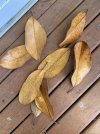Aquaticloch
Active Member
- Messages
- 157
- Location
- Canada eh
hey all,
I am looking for a good leaf for my aquariums that can be found readily near where i live.
I know many on this forum have used m.grandiflora leaves before in blackwater tanks, but i am wondering if Magnolia denudata and Magnolia x soulangeana can also be used, because the shape of the leaves IMO is more appealing than Oak or Maple. does anyone have experiences with this?
I have also read about an oily film on the surface of the aquarium whilst using grandiflora leaves, do you think it will be worse with these varieties? is there anything to worry about with these leaves, like laurels contain hydrocyanic acid?
also for future reference is there a rule of thumb for determining if the leaves are aquarium safe?
thanks all, sorry for all the rapid-fire questioning
I am looking for a good leaf for my aquariums that can be found readily near where i live.
I know many on this forum have used m.grandiflora leaves before in blackwater tanks, but i am wondering if Magnolia denudata and Magnolia x soulangeana can also be used, because the shape of the leaves IMO is more appealing than Oak or Maple. does anyone have experiences with this?
I have also read about an oily film on the surface of the aquarium whilst using grandiflora leaves, do you think it will be worse with these varieties? is there anything to worry about with these leaves, like laurels contain hydrocyanic acid?
also for future reference is there a rule of thumb for determining if the leaves are aquarium safe?
thanks all, sorry for all the rapid-fire questioning
